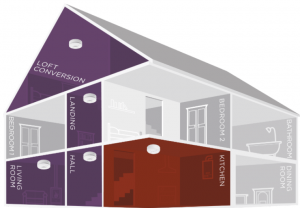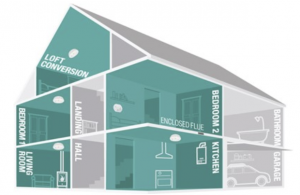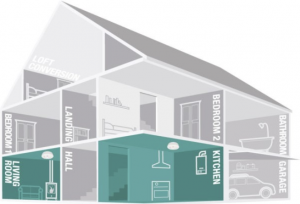NEW FIRE ALARM REGULATIONS – HOME OWNERS:
OWNER OCCUPIED PROPERTIES:
In-line with recent changes to the domestic fire alarm regulations [BS 5839 part 6 – 2019]
fire alarm detection system requirements within domestic properties have changed.
The below detail is for owner occupied properties only, other requirements exist where properties are rented.
It is not retrospective, so property owners don’t have to upgrade their system to the latest regulations,
UNLESS:
1. They would like to make sure the property is up to the latest fire regulations and is as safe as it can be.
2. If the property was majorly altered or rewired for example where notification to the local Council would be required. It would then have to be upgraded to the relevant grade.
Grade D2, LD2D – Owner Occupied – New Build (2-3 Storey).
Grade D2 – A system of one or more mains-powered detectors, each with an integral standby supply consisting of a user-replaceable battery or batteries.
Note D:
Heat detectors should be installed in every kitchen.
A smoke detector should be installed in the principal habitable room.
Where more than one room might be used as the principal habitable room, a smoke detector should be installed in each of these rooms.
GRADE D1A – system of one or more mains powered detectors, each with a tamper-proof standby supply consisting of a battery or batteries.
GRADE D2A – system of one or more mains powered detectors, each with an integral standby supply consisting of a user-replaceable battery or batteries.
Escape routes and high-risk areas, e.g.
- Hallway
- Landings
- Kitchen
- Living Room
Carbon Monoxide – British Standard BS EN 50292:2013:
Carbon Monoxide is a silent killer, you can’t see it, smell it or taste it.
This is why having Carbon Monoxide alarms installed throughout a property is so important. The British Standard BS EN 50292:2013 offers recommendations on the installation and maintenance of Carbon Monoxide alarms.
The standard states that a Carbon Monoxide alarm should be fitted in:

- Rooms that have any fuel burning appliances – such as an open fire, gas cooker or boiler.
- Rooms where people spend the most time – such as a living room.
- Rooms where people sleep.
- Any room that has a flue running through it.This means that a Carbon Monoxide leak can be detected from all the potential sources and heard throughout the property.
- That number of CO alarms are generally not installed,
so, if you have a limited number of alarms then you should look to cover the areas that are at highest risk including:

- Rooms with a flueless or open-flued appliances such as an open fire, gas cooker or portable heater – these would leak carbon monoxide directly into the room producing the greatest risk.
- Rooms where the occupants spend the most time – this is to ensure that they are protected to any carbon monoxide exposure in these areas and hear the alarm as soon as possible.






